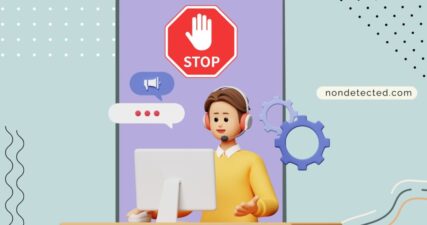How to Block a Search on Google and Other Search Engines?

Your online footprint is more than just a trail of digital breadcrumbs; it’s a neon billboard advertising your personal details to the world. Here at NonDetected, where we specialize in helping individuals like you regain control of their online privacy. This article is crafted to empower you with the knowledge to limit or block access to your information from being searchable on Google, a concern shared by many in our increasingly connected world.
For the other users, those who value their time and privacy, we at NonDetected offer our expertise to manage this process efficiently.
So, if you are not looking for guidelines but looking for assistance, you can simply fill out our contact form with details of your request, and our managers will get back to you ASAP.
For those who decided to do this on your own – the article will answer all your concerns.
What is the Challenge of Blocking Google Search Results?
Let’s start by addressing a common misconception: completely blocking oneself from Google searches is akin to trying to erase your footprints on a beach crowded with people; it’s a complex and often unfeasible task.
As a professional in the field, I can tell you that search engines like Google act as digital librarians, indexing vast volumes of information from the web. This includes data from social media sites, blogs, business websites, and more. They don’t directly control the information but rather guide users to where it exists.
Therefore, the key lies not in an outright blockade but in strategic management of your online presence.
Now, let’s talk METHODS.
Methods to Reduce Searchability
In our quest at NonDetected to shield your digital identity, let’s explore concrete steps to reduce your online searchability.
Enhancing Privacy on Social Media
Social media platforms are like open books of your personal life. To turn these pages private, adjust your privacy settings. On platforms like Facebook, navigate to ‘Settings’, then ‘Privacy’, and alter ‘Who can see my stuff?’ to ‘Friends’. For Instagram, go to ‘Settings’, select ‘Privacy’, and enable ‘Private Account’. These actions restrict the visibility of your profiles, making them less searchable on Google.
Removing Personal Information from Google
Sometimes, your personal information might appear on Google through various websites. To request its removal, use Google’s ‘Remove Outdated Content’ tool. Simply enter the URL containing your information and submit a removal request.
Remember, this tool works for content that no longer exists on the web, so ensure the information is deleted from the originating domain or site first.
Leter in this article I’ll give you a detailed guide on how to use this tool.
Dealing with Third-Party Websites
Data brokers collect and sell your information, making you more visible online. To combat this, identify major data broker sites like Spokeo or Whitepages and use their opt-out procedures to remove your information and block sites. This process can be time-consuming but is crucial in reducing your digital footprint.
Remember, at NonDetected, we understand that time is precious. For those who prefer an expert touch in managing these intricate processes, our team is always ready to step in and efficiently handle these privacy concerns for you.
How to Block Someone from Searching You on Google?

Now, let’s focus on tailoring what appears when someone searches your name on Google and how to block specific websites here.
Blocking Specific Google Searches
It’s important to understand that directly blocking specific search terms or results, or block websites on Google isn’t straightforward. Google and other search engines doesn’t provide a direct way to block certain Google search terms related to your name.
However, what you can do is influence what appears. This involves managing your online content and ensuring any negative or unwanted information is not easily accessible.
Using Google’s Tools
Google offers several tools to help manage your online presence. One key tool is the “Remove Outdated Content” tool. This is particularly useful for removing search results that are no longer live on the web but still appear in google’s search results.
Here is the exact step by step guide:
- Locate the exact URL of the outdated content. For example, if an old blog post about you has been deleted but still appears in search results, copy its specific link.
- Ensure the content is no longer accessible. This means the URL should lead to a page error like ‘404 Not Found’. Sometimes, a webpage may not display content but still exists, so make sure it’s completely removed or inaccessible.
- Access Google’s ‘Remove Outdated Content’ tool. It’s straightforward to find by searching Google, but ensure you’re using the official Google link to avoid any security issues.
- Enter the URL into the tool’s submission box accurately. Mistyping or omitting parts of the URL can lead to your request being denied due to URL mismatch.
- When submitting, you might have the option to provide context or additional information. Use this to explain why the content should be removed, enhancing the chances of a successful request.
- After submission, keep track of the request’s status. Google’s tool allows you to see whether your request is pending, approved, or denied. This process can take some time, so regular checks are advised.
Remember, this tool is for content that is no longer available online but still appears in your search engine results. If the content is still live in search result here, you’ll need to contact the website owner to remove it first.
At NonDetected, we navigate these complexities on your behalf, using our expertise to effectively manage your online presence. Our services are ideal for those who prefer a professional touch in ensuring their search results reflect the best of their digital footprint.
Advanced Strategies
For more intricate scenarios where basic privacy measures don’t suffice, advanced strategies come into play.
Legal Recourse
Utilizing legal means to remove information is a complex but sometimes necessary step. They are mostly used when all other options have gotten no results.
Here’s step by step guide on how to approach it:
- Identify the Nature of the Content. If the information is defamatory, violates copyright laws, or breaches privacy regulations, it may qualify for legal removal.
- Gather Evidence. Document the offending content and how it harms you.
- Legal Consultation. Seek advice from a lawyer specializing in internet law to understand your options.
- Legal Action. If advised, proceed with a formal legal request or a cease and desist letter to the content host.
Professional Services for Online Privacy
For comprehensive privacy management, professional services like NonDetected are invaluable.
Here’s what our service involves:
- We begin with a thorough assessment of your online footprint.
- Based on the assessment, we develop a customized strategy for removing or suppressing unwanted online information.
- Our team executes the strategy, handling all technical and legal complexities.
- We continuously monitor the web for any new mentions of your information.
Leveraging these advanced strategies effectively can be daunting. At NonDetected, we provide the expertise and support to walk through these steps, offering peace of mind and a cleaner digital footprint.
Preventative Measures to Block Certain Websites from Your Info
Below, I’ve outlined practical and actionable steps to bolster your digital defenses. These measures, from tweaking privacy settings to being judicious about what you share online, are your first line of defense in the vast digital landscape.
Let’s explore these preventative strategies, complete with examples, to help you maintain control over your online persona.
- Regularly Review Privacy Settings:
- Facebook: Go to ‘Settings & Privacy’, then ‘Settings’, and finally ‘Privacy’. Here, you can control who sees your posts and who can look you up using your email or phone number.
- Instagram: In ‘Settings’, select ‘Privacy’ and turn on the ‘Private Account’ option. This ensures only approved followers can see your posts.
- Be Mindful of Shared Information:
- Twitter/LinkedIn: Refrain from sharing personal details like your address or phone number. Even in seemingly harmless tweets or posts, this information can be used maliciously.
- Secure Your Data:
- Use password managers like LastPass or 1Password to create and store complex, unique passwords for each online account.
- Enable two-factor authentication (2FA) on critical accounts like your Google or Amazon profiles, adding an extra layer of security beyond just the password.
- Google Alerts:
- Set up alerts for your name on Google Alerts to monitor new internet mentions. This tool sends you email notifications whenever your name appears in new web content, helping you stay aware of your online presence.
Ready to clock Google search results?
To encapsulate, managing your online presence is a multifaceted task involving privacy adjustments, content removal strategies, and sometimes legal action.
At NonDetected, we streamline this process for you, but whether you choose professional help or go the DIY route, remember: ongoing vigilance is key to maintaining your digital privacy. It’s not just about fixing the current; it’s about safeguarding the future.


